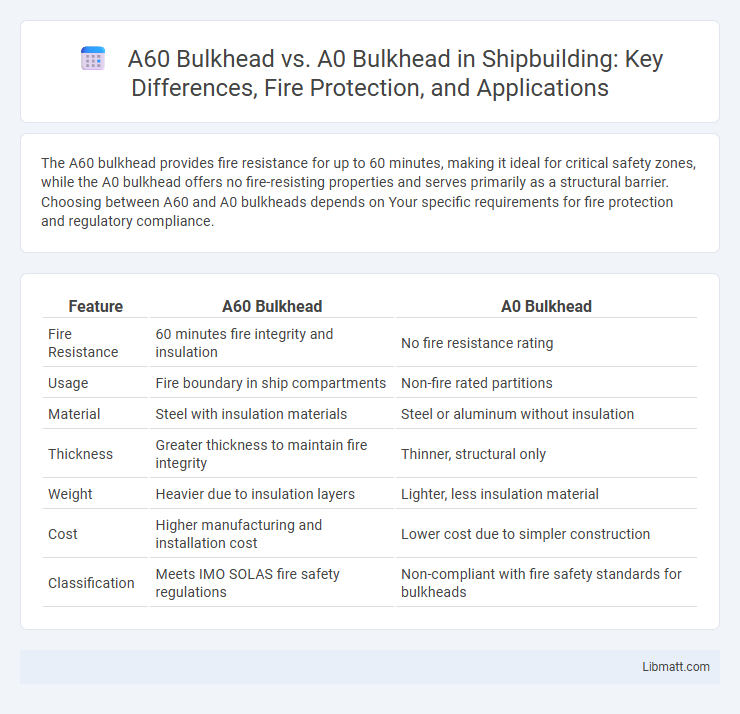The A60 bulkhead provides fire resistance for up to 60 minutes, making it ideal for critical safety zones, while the A0 bulkhead offers no fire-resisting properties and serves primarily as a structural barrier. Choosing between A60 and A0 bulkheads depends on Your specific requirements for fire protection and regulatory compliance.
Table of Comparison
| Feature | A60 Bulkhead | A0 Bulkhead |
|---|---|---|
| Fire Resistance | 60 minutes fire integrity and insulation | No fire resistance rating |
| Usage | Fire boundary in ship compartments | Non-fire rated partitions |
| Material | Steel with insulation materials | Steel or aluminum without insulation |
| Thickness | Greater thickness to maintain fire integrity | Thinner, structural only |
| Weight | Heavier due to insulation layers | Lighter, less insulation material |
| Cost | Higher manufacturing and installation cost | Lower cost due to simpler construction |
| Classification | Meets IMO SOLAS fire safety regulations | Non-compliant with fire safety standards for bulkheads |
Introduction to Bulkhead Fire Ratings
A60 bulkheads offer fire resistance for up to 60 minutes, providing critical protection in marine and offshore environments by containing fire spread and ensuring structural integrity. A0 bulkheads provide no fire resistance and are used primarily for non-fire-rated partitions where fire containment is not required. Understanding these bulkhead fire ratings is essential for compliance with safety regulations and effective fire management in vessel design.
Definition of A60 Bulkhead
An A60 bulkhead is a fire-resistant partition designed to withstand fire exposure for at least 60 minutes, complying with maritime safety standards. This type of bulkhead uses specific materials and construction techniques to provide a durable barrier that limits fire spread on ships and offshore structures. Your choice between A60 and A0 bulkheads impacts safety, with A60 offering significantly higher fire protection compared to the non-fire-resistant A0 bulkhead.
Definition of A0 Bulkhead
The A0 bulkhead, also known as the main or fireproof bulkhead, is a critical structural partition designed to separate the engine room from the rest of the vessel, providing maximum fire resistance and ensuring the safety of the ship. In contrast, the A60 bulkhead refers to a fire-resistant partition that can withstand fire for sixty minutes, often used in different ship compartments but less robust than an A0 bulkhead. The primary distinction lies in the fire rating and purpose, with the A0 bulkhead offering the highest level of protection crucial for compliance with marine safety regulations.
Construction Materials and Methods
The A60 bulkhead is constructed using fire-resistant materials such as steel and mineral wool insulation to provide a robust 60-minute fire protection barrier, making it suitable for high safety requirements. The A0 bulkhead typically uses lighter materials like steel without additional insulation, focusing on structural separation without fire resistance. Your choice depends on the required fire protection level and structural needs of the space.
Fire Resistance Performance Comparison
The A60 bulkhead offers superior fire resistance performance, designed to withstand fire exposure for 60 minutes, effectively containing flames and preventing heat transfer onboard ships and offshore platforms. In contrast, the A0 bulkhead provides minimal fire protection, primarily serving as a non-fire-rated partition with limited ability to resist fire spread. Your choice depends on safety requirements, as the A60 bulkhead is essential for high-risk areas needing robust fire containment, whereas the A0 bulkhead is suitable for non-critical zones.
Applications in Marine and Offshore Industries
The A60 bulkhead is widely used in marine and offshore industries for fire protection, providing a 60-minute fire resistance rating crucial in engine rooms, accommodation areas, and escape routes. In contrast, the A0 bulkhead serves primarily as a non-fire-rated partition, ideal for dividing spaces where fire resistance is not a regulatory requirement, such as storage rooms or utility compartments. Both bulkhead types are essential for compliance with SOLAS and classification society standards, ensuring safety and structural integrity in shipbuilding and offshore platform design.
Regulatory Standards and Compliance
The A60 bulkhead complies with stringent fire resistance standards such as IMO FTP Code Part 3, ensuring a minimum 60 minutes of fire integrity and insulation, making it suitable for marine vessels requiring high safety classifications. In contrast, the A0 bulkhead meets the basic fire resistance requirement of zero minutes, primarily serving as a non-fire-resistant partition under classifications like SOLAS regulations. Understanding the compliance differences between A60 and A0 bulkheads is critical for meeting international maritime safety regulations and choosing the appropriate bulkhead for specific shipboard applications.
Advantages of A60 Bulkhead
A60 bulkheads offer superior fire resistance, providing up to 60 minutes of fire protection compared to A0 bulkheads, which have no fixed fire-rating. This makes A60 bulkheads essential in enhancing safety by preventing fire and smoke spread between compartments on ships and offshore platforms. Their robust construction also contributes to improved structural integrity and compliance with stringent maritime safety regulations.
Limitations of A0 Bulkhead
The A0 bulkhead design often faces limitations such as reduced structural rigidity and lower load-bearing capacity compared to the A60 bulkhead, which offers enhanced fire resistance up to 60 minutes. Your choice of A0 bulkhead may compromise safety standards and fail to meet stringent maritime regulations for fire protection. These constraints make the A60 bulkhead the preferred option for critical applications demanding higher durability and compliance.
Choosing the Right Bulkhead for Your Project
Choosing the right bulkhead between A60 and A0 depends on fire resistance requirements and project specifications. A60 bulkheads provide up to 60 minutes of fire protection, making them suitable for areas needing enhanced safety measures, while A0 bulkheads offer no fire resistance but are ideal for non-critical partitions prioritizing cost-efficiency and ease of installation. Evaluating project safety standards, budget constraints, and compliance with building regulations ensures the optimal bulkhead selection.
A60 bulkhead vs A0 bulkhead Infographic

 libmatt.com
libmatt.com